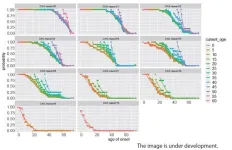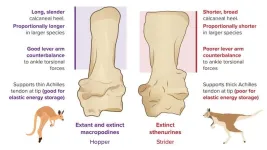(Press-News.org) A University of Waterloo engineer’s MRI invention reveals better than many existing imaging technologies how COVID-19 can change the human brain.
The new imaging technique known as correlated diffusion imaging (CDI) was developed by systems design engineering professor Alexander Wong and recently used in a groundbreaking study by scientists at Baycrest’s Rotman Research Institute and Sunnybrook Hospital in Toronto.
“Some may think COVID-19 affects just the lungs,” Dr. Wong said. “What was found is that this new MRI technique that we created is very good at identifying changes to the brain due to COVID-19. COVID-19 changes the white matter in the brain.”
Wong, a Canada Research Chair in Artificial Intelligence and Medical Imaging, had previously developed CDI in a successful search for a better imaging measure for detecting cancer. CDI is a new form of MRI that can better highlight the differences in the way water molecules move in tissue by capturing and mixing MRI signals at different gradient pulse strengths and timings.
Researchers at Rotman, a world-renowned centre for the study of brain function, saw Wong’s imaging discovery and thought it could likely also be used to identify changes to the brain due to COVID-19. Subsequent tests proved that theory right. The CDI imaging of frontal-lobe white matter revealed a less restricted diffusion of water molecules in COVID-19 patients. At the same time, it showed a more restricted diffusion of water molecules in the cerebellum of patients with COVID-19.
Wong highlights that the two regions of the brain react differently to COVID-19 and points to two key findings from the research. First, the human cerebellum might be more vulnerable to COVID-19 infections. Second, the study reinforces the idea that COVID-19 infections can lead to changes in the brain.
Not only is the Rotman study one of the few to have shown COVID-19’s effects on the brain, but it is the first to report diffusion abnormalities in the white matter of the cerebellum. Although the study was designed to show changes, rather than specific damage, to the brain from COVID-19, its final report does discuss potential sources of such changes and many link to disease and damage.
In response, Wong suggests future tests could focus on whether COVID-19 actually damages brain tissue. Additional studies could also determine if COVID-19 can change the brain’s grey matter.
“Hopefully, this research can lead to better diagnoses and treatments for COVID-19 patients,” Wong said. “And that could just be the beginning for CDI as it might be used to understand degenerative processes in other diseases such as Alzheimer’s or to detect breast or prostate cancers.”
The study, Feasibility of diffusion-tensor and correlated diffusion imaging for studying white-matter microstructural abnormalities: Application in COVID-19, which involves Wong and his student Hayden Gunraj as co-authors, is published in the journal Human Brain Mapping.
END
New imaging technique captures COVID-19’s impact on the brain
2023-06-14
ELSE PRESS RELEASES FROM THIS DATE:
Prediction of age of onset of SCA3 and DRPLA by survival analysis using machine learning
2023-06-14
Niigata, Japan – Using machine learning, the Department of Neurology at Niigata University has developed a model to predict the asymptomatic probability at each age from the current age and number of CAG repeats in carriers of spinocerebellar degeneration. Polyglutamine diseases such as DRPLA and SCA3 are caused by an expansion of CAG repeats in the causative gene. In polyglutamine diseases, the number of CAG repeats is known to be inversely related to age of onset. Parametric survival analysis has traditionally been used to predict age of onset, but a more accurate prediction method has been desired. We ...
Remission rates of 1 in 100 people with type 2 diabetes in real world data
2023-06-14
Niigata, Japan - The phenomenon of improvement of glucose to levels in a normal range and cessation of the need for medication can occur in some patients diagnosed with type 2 diabetes who are provided with lifestyle therapy, temporary pharmacotherapy, bariatric surgery, or combinations of these treatments. However, this phenomenon is not yet fully understood in routine care settings, and many factors remain to be clarified. Moreover, since there are differences in insulin secretion and resistance between East Asian and Western populations, the natural history of diabetes seems to differ widely between Western populations and East Asians.
Therefore, ...
Sharpening Occam’s Razor
2023-06-14
In science, the explanation with the fewest assumptions is most likely to be true. Called “Occam’s Razor,” this principle has guided theory and experiment for centuries. But how do you compare between abstract concepts?
In a new paper, philosophers from UC Santa Barbara and UC Irvine discuss how to weigh the complexity of scientific theories by comparing their underlying mathematics. They aim to characterize the amount of structure a theory has using symmetry — or the aspects of an object that remain the same when other changes are made.
After much ...
C-Path’s PSTC receives positive FDA response for drug-induced pancreatic injury biomarkers
2023-06-14
Safety biomarkers aim to provide an additional tool for detecting acute drug-induced pancreatic injury (DIPI) in phase 1 clinical trials
TUCSON, Ariz., June 13, 2023 — Critical Path Institute (C-Path) today announced that the Biomarker Qualification Program (BQP) at the Center for Drug Evaluation and Research (CDER) in the U.S. Food and Drug Administration (FDA) issued a Biomarker Letter of Support (LOS) for four pancreatic injury safety biomarkers identified and evaluated by C-Path’s Predictive Safety Testing Consortium's (PSTC) Pancreatic Injury Working Group (PIWG).
This set of biomarkers will help increase the ability ...
Breaking barriers: Advancements in meta-holographic display enable ultraviolet domain holograms
2023-06-14
The term meta means a concept of transcendence or surpassing, and when applied to materials, metamaterials encompass artificially engineered substances that exhibit properties not naturally found in the environment. Metasurfaces, characterized by their thinness and lightness, have garnered considerable interest as a potential component for incorporation into portable augmented reality (AR) and virtual reality (VR) devices to facilitate holographic generation. Nonetheless, it is important to note that metasurfaces have inherent limitations, such ...
Bhopal explosion may have heightened risk of disability and cancer among future generations
2023-06-14
The Bhopal gas explosion in 1984—one of India’s worst industrial disasters—may have heightened the risk of disability and cancer in later life among future generations, curbed their educational attainment, and prompted a fall in the proportion of male births the following year, suggests research in the open access journal BMJ Open.
The disaster is likely to have affected people across a substantially more extensive area than previous evidence suggested, say the researchers.
During the incident, toxic ...
NHS “flying blind” in attempt to tackle ethnic inequalities in care, warns expert
2023-06-14
The NHS will be “flying blind” in its attempts to meet its legal, and moral, obligation to eliminate ethnic inequalities in health and care until longstanding problems with the quality of ethnicity data are resolved, warns an expert in The BMJ today.
Inequalities in health and care between ethnic groups have been documented for decades, explains Sarah Scobie at the Nuffield Trust. But she argues that analysis by broad ethnic groups (white, Asian, black, and mixed) can mask substantial variation within them.
An accompanying infographic presents some of these disparities across a range ...
Timing of childhood adversity is associated with unique epigenetic patterns in adolescents
2023-06-14
BOSTON—Childhood adversity—circumstances that threaten to a child’s physical or psychological well-being--has long been associated with poorer physical and mental health throughout life, such as greater risks of developing cardiac disease, cancer, or depression. It remains unclear, however, when and how the effects of childhood adversity become biologically embedded to influence health outcomes in children, adolescents, and adults.
A team of researchers at Massachusetts General Hospital (MGH), a founding member of Mass General Brigham (MGB), previously showed that exposure to adversity between ages 3 to 5 has a ...
Lockdown children played on, study finds, despite being stuck at home
2023-06-14
Children displayed a resilient capacity to continue playing during peak COVID-19, a study has found, even though their options to do so became more limited while under stay-at-home orders.
The research, by academics at the University of Cambridge, interviewed children themselves about their playing habits during the pandemic. Without disputing the consensus that COVID-19 impeded children’s healthy development, it does suggest that they were able to adapt their play habits to their changed circumstances.
Children largely expressed ...
Skipping evolution: some kangaroos didn’t hop, scientists explain
2023-06-14
Extinct kangaroos used alternative methods to their famous hop according to comprehensive analysis from University of Bristol and the University of Uppsala scientists.
Although hopping is regarded as a pinnacle of kangaroo evolution, the researchers highlight that other kinds of large kangaroos, in the not too distant past, likely moved in different ways such as striding on two legs or traversing on all fours.
In the review, published in Alcheringa: An Australasian Journal of Palaeontology, the team shows that there are other ways to be an evolutionary ...



